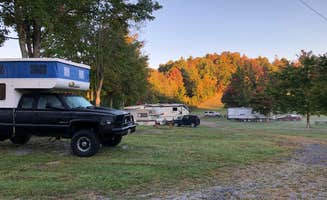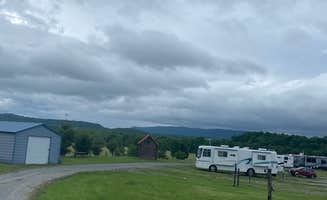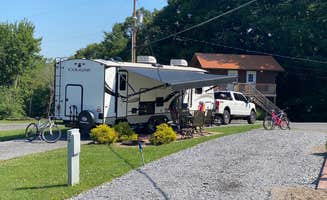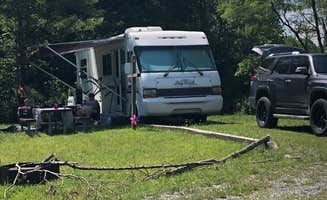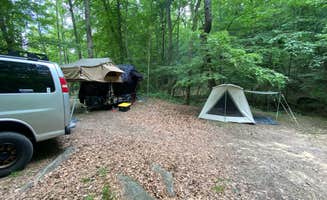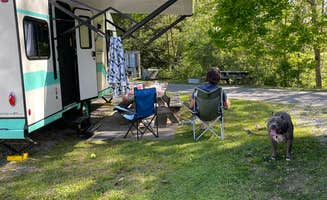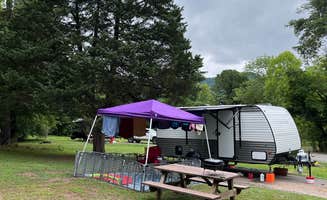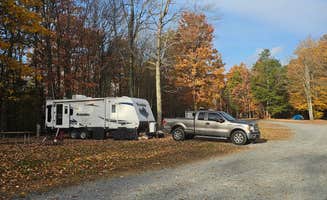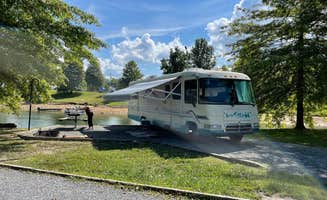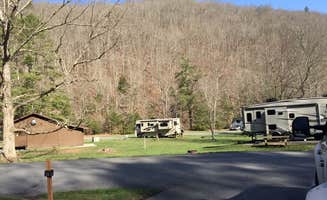New River Gorge National Park and Preserve features over 70,000 acres of rugged terrain surrounding the New River, one of the oldest rivers in North America at 360 million years. The region sits at elevations ranging from 1,400 to 2,500 feet, creating dramatic temperature variations between riverside campsites and those on higher ground. During summer months, river valley camping areas typically experience temperatures 10-15 degrees warmer than mountaintop locations near Prince.
What to Do
River access activities: At Army Camp Campground, campers can enjoy swimming, fishing, and watching rafters navigate the New River. "The view of the river is absolutely beautiful!" notes a visitor who appreciated the easy water access despite the trip in. During warmer months, evening river dips provide welcome relief from summer heat.
Historic exploration: The abandoned mining town of Thurmond sits near Stone Cliff Campground, offering glimpses into the region's coal mining past. "Stone Cliff is my favorite place to camp... Great area for people to swim in the river or fish," mentions a regular visitor. Military history enthusiasts will find interest in the Army Camp training remains visible along the gravel road leading to the campground.
Hiking trails: Multiple trails connect directly from campsites to longer routes. "There is a short trail on far side of parking area" at Army Camp, while Glade Creek Trail follows an old railroad bed with several branching trails including one to Kates Falls. Many trails accommodate mountain bikes, making this region popular with cyclists seeking moderate terrain challenges.
What Campers Like
Affordability: Free camping options provide excellent value. "Hard to beat a free campsite right on the river," remarks one Army Camp visitor. Multiple no-cost campgrounds allow 14-day maximum stays, making extended explorations possible without breaking the budget. For those seeking minimal amenities, these sites offer basic comforts without reservation requirements.
Privacy between sites: Campers appreciate the spacing at Glade Creek Campground, where "the tent sites were closer than I thought, but were still nicely equipped with a fire pit, charcoal grill, and picnic table." Sites typically maintain 50+ feet of separation at Army Camp, with outer perimeter sites providing more seclusion than inner loop locations.
Natural soundscapes: The constant white noise from flowing water creates a peaceful backdrop. "The flowing Gorge can always be heard, the low rumble is peaceful at night," notes a camper at Glade Creek. Train sounds periodically interrupt the natural ambiance at some campgrounds, with regular freight traffic following the historic rail lines through the gorge.
What You Should Know
Limited facilities: Most riverside campgrounds offer only basic amenities. "No drinking water at any of these campgrounds. You must bring water or filter it from the New River," cautions an experienced visitor. Pit latrines represent the only sanitation facilities at free campgrounds, though their condition varies significantly.
Road conditions: Access to Hilltop Sunrise and other area campgrounds requires navigating challenging roads. "The road getting back to the site is a little sketch but worth the trip in," explains a camper, emphasizing the need to bring all supplies since forgotten items mean repeating difficult drives. Single-lane roads with limited passing areas pose challenges for larger vehicles.
Seasonal water levels: Spring and early summer bring higher water levels to riverside campgrounds. "When breaking camp, it was noted the New River had encroached another 100ft through the woodland, flowing alongside the campground loop gravel drive," warns a visitor about Army Camp, illustrating how even without active rain, river levels can continue rising unexpectedly.
Tips for Camping with Families
Kid-friendly water play: Pipestem RV Park offers structured water recreation options. "We enjoyed lots of the amenities, including the horseback riding, nature center and giant water inflatables," mentions a family in a 37-foot travel trailer. The combination of natural and developed recreation areas provides options for different age groups.
Wildlife encounters: Children can observe diverse wildlife throughout the region. "Song birds, robins and crows competed vocally during daylight hours. Interesting insects crawled the river's sandy shore and a brightly colored Eastern box turtle searched for higher-dryer ground," describes a visitor documenting natural discoveries near Army Camp.
Food storage discipline: "The raccoons at night have a schedule of getting any foods left out. Putting everything away is a must," warns a family at Pipestem. Teaching children proper food storage becomes an educational opportunity while preventing unwanted campsite visitors and associated cleanup.
Tips from RVers
Site accessibility: Summer Wind RV Park provides easier access for larger rigs. "Easy off and on the interstate and we fit fine driving 40' towing," confirms one traveler. The park's location near I-64 makes it convenient for overnight stops, with pull-through sites accommodating bigger setups without difficult maneuvering.
Site levelness: RVers report mixed experiences with site grading throughout the region. "Site 34" at Rifrafters Campground is recommended by a traveler who notes, "Up front is a regular campground but we are in the back, secluded and peaceful." At Summer Wind, "easy level spots row c is best (which is where 50 amps are)."
Connectivity concerns: Cell service varies dramatically across the area. "Starlink access was excellent as there is not a single tree to obstruct the view!" reports a camper at Summer Wind who stayed for a week. For those requiring reliable internet, researching connectivity options in advance prevents productivity disruptions during longer stays.


